Enhancing Methyl Orange Degradation with Laser-Generated ZnO and Ce-Doped ZnO Nanoparticles
Abstract
:1. Introduction
2. Materials and Methods
2.1. Material
2.2. Synthesis of Ce-Doped ZnO Nanoparticles by CO2 Laser
2.3. Photocatalytic Activity
2.4. Removal Efficiency of Degradation
2.5. Kinetics Studies of Photocatalysis
2.6. Isotherms Study of Dye Molecules
3. Results and Discussion
3.1. Nanoparticle Production: Photothermal Effect and Laser Decomposition
3.2. Characterizations
3.2.1. XRD Analysis
3.2.2. FESEM and EDX Analysis
3.2.3. Optical Properties of the Prepared Samples
3.3. Photocatalytic Degradation of MO Dye
3.4. The Mechanisms of Action
4. Conclusions
Supplementary Materials
Author Contributions
Funding
Institutional Review Board Statement
Informed Consent Statement
Data Availability Statement
Acknowledgments
Conflicts of Interest
References
- Nguyen-Hong, Y.X.; Luu, T.V.H.; Doan, V.D. Green synthesis of Ce-doped ZnO nanoparticles using Hedyotis capitellata Leaf extract for efficient photocatalytic degradation of Methyl Orange. Vietnam. J. Chem. 2021, 59, 648–659. [Google Scholar]
- Dutta, P.; Rabbi, M.R.; Abu Sufian, M.; Mahjebin, S. Effects of textile dyeing effluent on the environment and its treatment: A review. Eng. Appl. Sci. Lett. 2022, 5, 1. [Google Scholar]
- Abdelhamid, M.; Korte, D.; Cabrera, H.; Pliekhova, O.; Ebrahimpour, Z.; Lavrenčič Štangar, U.; Franko, M. Thermo-Optical Characterization of Cu- and Zr-Modified TiO 2 Photocatalysts by Beam Deflection Spectrometry. Appl. Sci. 2021, 11, 10937. [Google Scholar] [CrossRef]
- Iqbal, J.; Jan, T.; Ismail, M.; Ahmad, N.; Arif, A.; Khan, M.; Adil, M.; Arshad, A. Influence of Mg doping level on morphology, optical, electrical properties and antibacterial activity of ZnO nanostructures. Ceram. Int. 2014, 40, 7487–7493. [Google Scholar] [CrossRef]
- Al Abri, R.; Al Marzouqi, F.; Kuvarega, A.T.; Meetani, M.A.; Al Kindy, S.M.; Karthikeyan, S.; Kim, Y.; Selvaraj, R. Nanostructured cerium-doped ZnO for photocatalytic degradation of pharmaceuticals in aqueous solution. J. Photochem. Photobiol. A Chem. 2019, 384, 112065. [Google Scholar] [CrossRef]
- Guan, Y.; Pedraza, A. Synthesis and alignment of Zn and ZnO nanoparticles by laser-assisted chemical vapor deposition. Nanotechnology 2008, 19, 045609. [Google Scholar] [CrossRef]
- Sethi, M.; Bhat, D.K. Facile solvothermal synthesis and high supercapacitor performance of NiCo2O4 nanorods. J. Alloys Compd. 2019, 781, 1013–1020. [Google Scholar] [CrossRef]
- Asma, F.; Prasetyo, W.; Nurhasanah, I. Synthesize of Cerium-doped ZnO nanoparticles as antioxidant agent. J. Phys. Conf. Ser. 2021, 2190, 012045. [Google Scholar] [CrossRef]
- Dao, T.-P.; Huang, S.-C. Design and multi-objective optimization for a broad self-amplified 2-DOF monolithic mechanism. Sādhanā 2017, 42, 1527–1542. [Google Scholar] [CrossRef]
- Ai, J.P.; Liao, W.X.; Luo, S.S.; Zhou, T.; Cheng, L.H.; Chen, Z.Q.; Chen, Y.; Yang, Y.L.; Li, W.K. Hydrothermal Method Preparation of Flower-Like Ce-Doped ZnO as an Efficient Photocatalyst. Solid State Phenom. 2018, 281, 872–877. [Google Scholar] [CrossRef]
- Lang, J.; Wang, J.; Zhang, Q.; Li, X.; Han, Q.; Wei, M.; Sui, Y.; Wang, D.; Yang, J. Chemical precipitation synthesis and significant enhancement in photocatalytic activity of Ce-doped ZnO nanoparticles. Ceram. Int. 2016, 42, 14175–14181. [Google Scholar] [CrossRef]
- Chouchene, B.; Chaabane, T.B.; Balan, L.; Girot, E.; Mozet, K.; Medjahdi, G.; Schneider, R. High performance Ce-doped ZnO nanorods for sunlight-driven photocatalysis. Beilstein J. Nanotechnol. 2016, 7, 1338–1349. [Google Scholar] [CrossRef]
- Faisal, M.; Ismail, A.A.; Ibrahim, A.A.; Bouzid, H.; Al-Sayari, S.A. Highly efficient photocatalyst based on Ce doped ZnO nanorods: Controllable synthesis and enhanced photocatalytic activity. Chem. Eng. J. 2013, 229, 225–233. [Google Scholar] [CrossRef]
- Kumar, R.; Umar, A.; Kumar, G.; Akhtar, M.; Wang, Y.; Kim, S. Ce-doped ZnO nanoparticles for efficient photocatalytic degradation of direct red-23 dye. Ceram. Int. 2015, 41, 7773–7782. [Google Scholar] [CrossRef]
- Baig, F.; Ashraf, M.W.; Asif, A.; Imran, M. A comparative analysis for effects of solvents on optical properties of Mg doped ZnO thin films for optoelectronic applications. Optik 2020, 208, 164534. [Google Scholar] [CrossRef]
- Poondi, D.; Subramanian, R.; Otooni, M.; Singh, J. Synthesis of Silver Nanoparticles by a Laser–Liquid–Solid Interaction Technique. J. Mater. Synth. Process. 1998, 6, 89–104. [Google Scholar] [CrossRef]
- Abebe, B.; Murthy, H.A.; Amare, E. Enhancing the photocatalytic efficiency of ZnO: Defects, heterojunction, and optimization. Environ. Nanotechnol. Monit. Manag. 2020, 14, 100336. [Google Scholar] [CrossRef]
- Rajendran, S.; Khan, M.M.; Gracia, F.; Qin, J.; Gupta, V.K.; Arumainathan, S. Ce3+-ion-induced visible-light photocatalytic degradation and electrochemical activity of ZnO/CeO2 nanocomposite. Sci. Rep. 2016, 6, 31641. [Google Scholar] [CrossRef]
- Elsayed, M.S.; Ahmed, I.A.; Bader, D.M.; Hassan, A.F. Green synthesis of nano zinc oxide/nanohydroxyapatite composites using date palm pits extract and eggshells: Adsorption and photocatalytic degradation of methylene blue. Nanomaterials 2021, 12, 49. [Google Scholar] [CrossRef]
- Fauteux, C.; Longtin, R.; Pegna, J.; Therriault, D. Fast synthesis of ZnO nanostructures by laser-induced decomposition of zinc acetylacetonate. Inorg. Chem. 2007, 46, 11036–11047. [Google Scholar] [CrossRef]
- Inaba, H.; Ito, H. Observation of power-dependent distortion of an infrared beam at 10.6 μm from a CO2 laser during propagation in liquids. IEEE J. Quantum Electron. 1968, 4, 45–48. [Google Scholar] [CrossRef]
- Jaleh, B.; Nasrollahzadeh, M.; Mohazzab, B.F.; Eslamipanah, M.; Sajjadi, M.; Ghafuri, H. State-of-the-art technology: Recent investigations on laser-mediated synthesis of nanocomposites for environmental remediation. Ceram. Int. 2021, 47, 10389–10425. [Google Scholar] [CrossRef]
- Bonardi, A.-H.l.; Dumur, F.d.r.; Gigmes, D.; Xu, Y.-Y.; Lalevée, J. Light-induced thermal decomposition of alkoxyamines upon infrared CO2 laser: Toward spatially controlled polymerization of methacrylates in laser write experiments. ACS Omega 2020, 5, 3043–3046. [Google Scholar] [CrossRef] [PubMed]
- Xin, M. Crystal structure and optical properties of ZnO: Ce nano film. Molecules 2022, 27, 5308. [Google Scholar] [CrossRef]
- Rodwihok, C.; Choopun, S.; Ruankham, P.; Gardchareon, A.; Phadungdhitidhada, S.; Wongratanaphisan, D. UV sensing properties of ZnO nanowires/nanorods. Appl. Surf. Sci. 2019, 477, 159–165. [Google Scholar] [CrossRef]
- Rodwihok, C.; Wongratanaphisan, D.; Tam, T.V.; Choi, W.M.; Hur, S.H.; Chung, J.S. Cerium-oxide-nanoparticle-decorated zinc oxide with enhanced photocatalytic degradation of methyl orange. Appl. Sci. 2020, 10, 1697. [Google Scholar] [CrossRef]
- Kannadasan, N.; Shanmugam, N.; Cholan, S.; Sathishkumar, K.; Viruthagiri, G.; Poonguzhali, R. The effect of Ce4+ incorporation on structural, morphological and photocatalytic characters of ZnO nanoparticles. Mater. Charact. 2014, 97, 37–46. [Google Scholar] [CrossRef]
- Wang, P.; Meng, F.; Gao, C.; Xie, W.; Wang, J.; Li, A. Structural, morphological and optical characteristics of fusiform Co-doped CeO 2 via a facile hydrothermal method. J. Mater. Sci. Mater. Electron. 2018, 29, 11482–11488. [Google Scholar] [CrossRef]
- Jiang, J.; Zhang, K.; Chen, X.; Zhao, F.; Xie, T.; Wang, D.; Lin, Y. Porous Ce-doped ZnO hollow sphere with enhanced photodegradation activity for artificial waste water. J. Alloys Compd. 2017, 699, 907–913. [Google Scholar] [CrossRef]
- Abdelouhab, Z.A.; Djouadi, D.; Chelouche, A.; Hammiche, L.; Touam, T. Structural and morphological characterizations of pure and Ce-doped ZnO nanorods hydrothermally synthesized with different caustic bases. Mater. Sci.-Pol. 2020, 38, 228–235. [Google Scholar] [CrossRef]
- Djouadi, D.; Slimi, O.; Hammiche, L.; Chelouche, A.; Touam, T. Effects of (Ce, Cu) Co-doping on the Structural and Optical Properties of ZnO Aerogels Synthesized in Supercritical Ethanol. J. Phys. Conf. Ser. 2018, 987, 012008. [Google Scholar] [CrossRef]
- Mohammed, M.; Abdul Razak, A.A.; Hussein Al-Timimi, D.A. Modified multiwalled carbon nanotubes for treatment of some organic dyes in wastewater. Adv. Mater. Sci. Eng. 2014, 2014, 201052. [Google Scholar] [CrossRef]
- Phokha, S.; Pinitsoontorn, S.; Chirawatkul, P.; Poo-Arporn, Y.; Maensiri, S. Synthesis, characterization, and magnetic properties of monodisperse CeO2 nanospheres prepared by PVP-assisted hydrothermal method. Nanoscale Res. Lett. 2012, 7, 1–13. [Google Scholar] [CrossRef]
- Tarat, A.; Nettle, C.J.; Bryant, D.T.; Jones, D.R.; Penny, M.W.; Brown, R.A.; Majitha, R.; Meissner, K.E.; Maffeis, T.G. Microwave-assisted synthesis of layered basic zinc acetate nanosheets and their thermal decomposition into nanocrystalline ZnO. Nanoscale Res. Lett. 2014, 9, 11. [Google Scholar] [CrossRef]
- Sfirloaga, P.; Ivanovici, M.-G.; Poienar, M.; Ianasi, C.; Vlazan, P. Investigation of Catalytic and Photocatalytic Degradation of Methyl Orange Using Doped LaMnO3 Compounds. Processes 2022, 10, 2688. [Google Scholar] [CrossRef]
- Wang, Q.; Zhao, S.; Zhao, Y.; Deng, Y.; Yang, W.; Ye, Y.; Wang, K. Construction of Z-scheme Bi2O3/CeO2 heterojunction for enhanced photocatalytic capacity of TiO2 NTs. Spectrochim. Acta Mol. Biomol. Spectrosc. 2023, 304, 123405. [Google Scholar] [CrossRef] [PubMed]
- Wang, Q.; Zhao, Y.; Zhang, Z.; Liao, S.; Deng, Y.; Wang, X.; Ye, Q.; Wang, K. Hydrothermal preparation of Sn3O4/TiO2 nanotube arrays as effective photocatalysts for boosting photocatalytic dye degradation and hydrogen production. Ceram. Int. 2023, 49, 5977–5985. [Google Scholar] [CrossRef]
- Wang, Q.; Zhu, S.; Zhao, S.; Li, C.; Wang, R.; Cao, D.; Liu, G. Construction of Bi-assisted modified CdS/TiO2 nanotube arrays with ternary S-scheme heterojunction for photocatalytic wastewater treatment and hydrogen production. Fuel 2022, 322, 124163. [Google Scholar] [CrossRef]
- Jia, Y.; Liu, P.; Wang, Q.; Wu, Y.; Cao, D.; Qiao, Q.-A. Construction of Bi2S3-BiOBr nanosheets on TiO2 NTA as the effective photocatalysts: Pollutant removal, photoelectric conversion and hydrogen generation. J. Colloid Interface Sci. 2021, 585, 459–469. [Google Scholar] [CrossRef]
- Wang, Q.; Li, H.; Yu, X.; Jia, Y.; Chang, Y.; Gao, S. Morphology regulated Bi2WO6 nanoparticles on TiO2 nanotubes by solvothermal Sb3+ doping as effective photocatalysts for wastewater treatment. Electrochim. Acta 2020, 330, 135167. [Google Scholar] [CrossRef]
- Pathak, T.K.; Coetsee-Hugo, E.; Swart, H.; Swart, C.; Kroon, R. Preparation and characterization of Ce doped ZnO nanomaterial for photocatalytic and biological applications. Mater. Sci. Eng. B 2020, 261, 114780. [Google Scholar] [CrossRef]
- Palneedi, H.; Park, J.H.; Maurya, D.; Peddigari, M.; Hwang, G.T.; Annapureddy, V.; Kim, J.W.; Choi, J.J.; Hahn, B.D.; Priya, S. Laser processing of metal oxides: Laser irradiation of metal oxide films and nanostructures: Applications and advances (Adv. Mater. 14/2018). Adv. Mater. 2018, 30, 1870094. [Google Scholar] [CrossRef]
- Mateen, S.; Nawaz, R.; Qamar, M.T.; Ali, S.; Iqbal, S.; Aslam, M.; Raheel, M.; Awwad, N.S.; Ibrahium, H.A. Integration of WO3-Doped MoO3 with ZnO Photocatalyst for the Removal of 2-Nitrophenol in Natural Sunlight Illumination. Catalysts 2023, 13, 1262. [Google Scholar] [CrossRef]
- Cao, Q.; Li, Q.; Pi, Z.; Zhang, J.; Sun, L.-W.; Xu, J.; Cao, Y.; Cheng, J.; Bian, Y. Metal–organic-framework-derived ball-flower-like porous Co3O4/Fe2O3 heterostructure with enhanced visible-light-driven photocatalytic activity. Nanomaterials 2022, 12, 904. [Google Scholar] [CrossRef]
- Alahiane, S.; Sennaoui, A.; Sakr, F.; Qourzal, S.; Dinne, M.; Assabbane, A. A study of the photocatalytic degradation of the textile dye Reactive Yellow 17 in aqueous solution by TiO2-coated non-woven fibres in a batch photoreactor. J. Mater. Environ. Sci. 2017, 8, 3556–3563. [Google Scholar]
- Kumar, M.; Chauhan, M.S.; Akhtar, M.S.; Umar, A. Effect of cerium ions in Ce-Doped ZnO nanostructures on their photocatalytic and picric acid chemical sensing. Ceram. Int. 2021, 47, 3089–3098. [Google Scholar] [CrossRef]
- Djaja, N.F.; Saleh, R. Characteristics and photocatalytics activities of Ce-doped ZnO nanoparticles. Mater. Sci. Appl. 2013, 4, 145. [Google Scholar] [CrossRef]
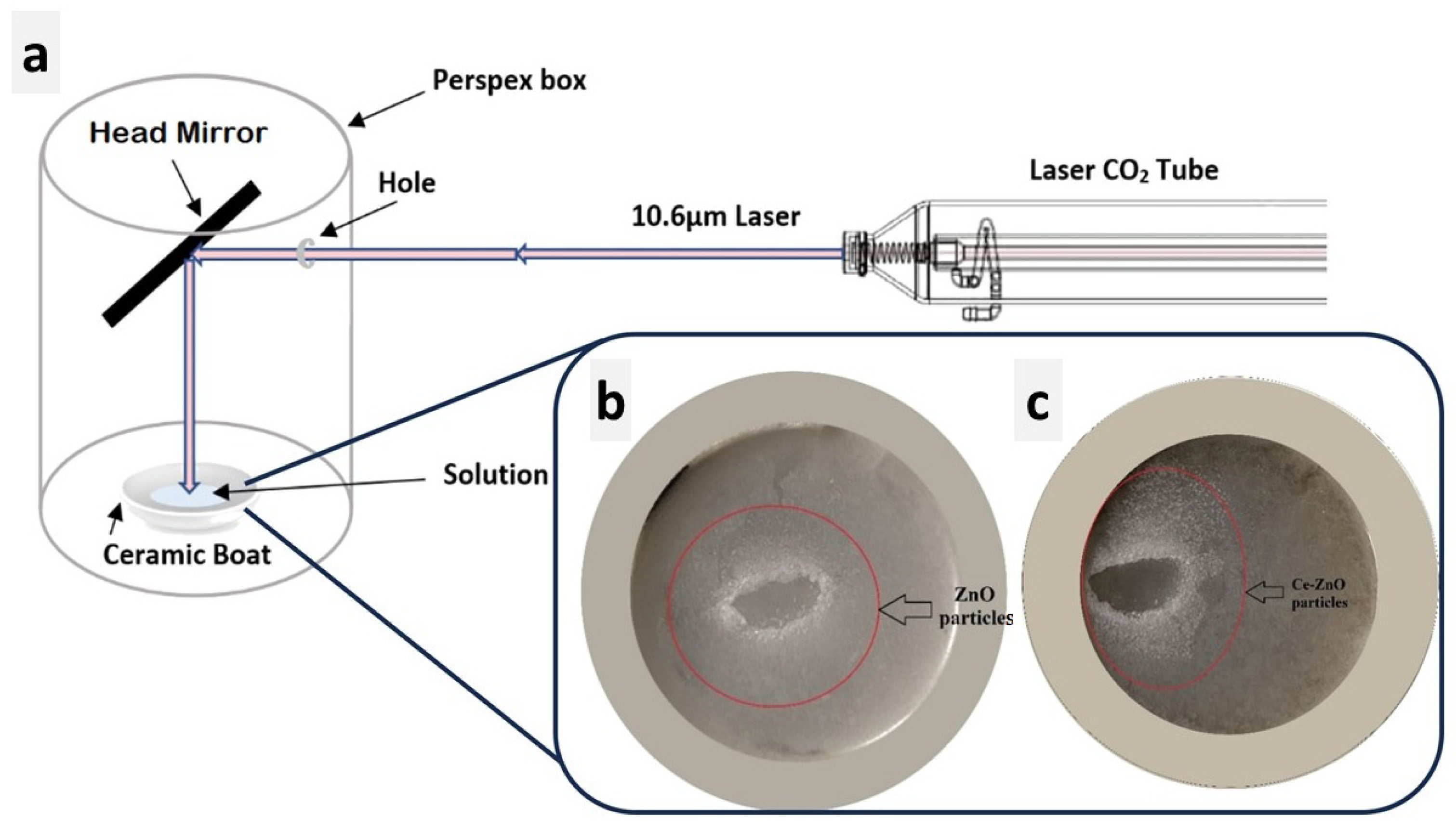

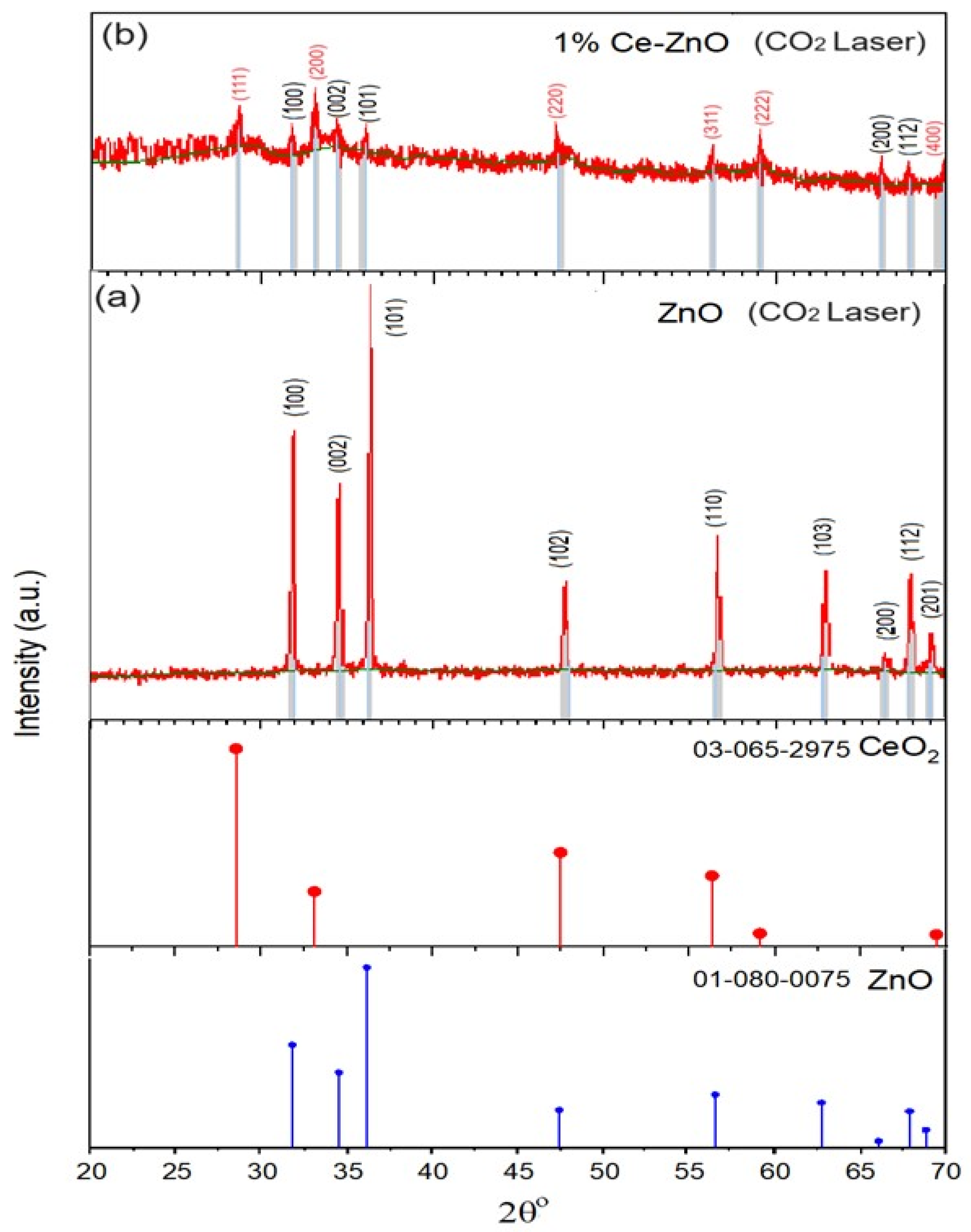
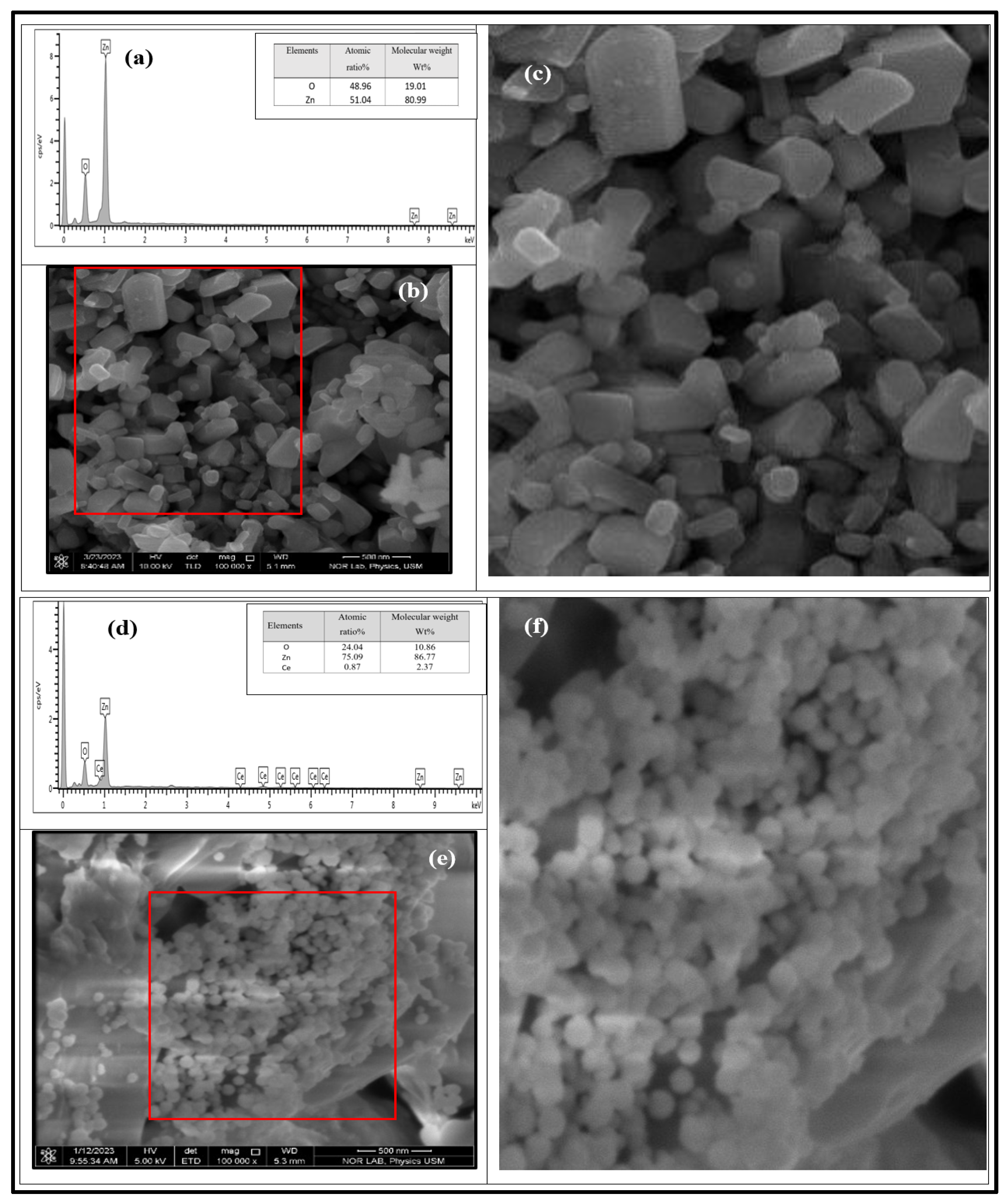
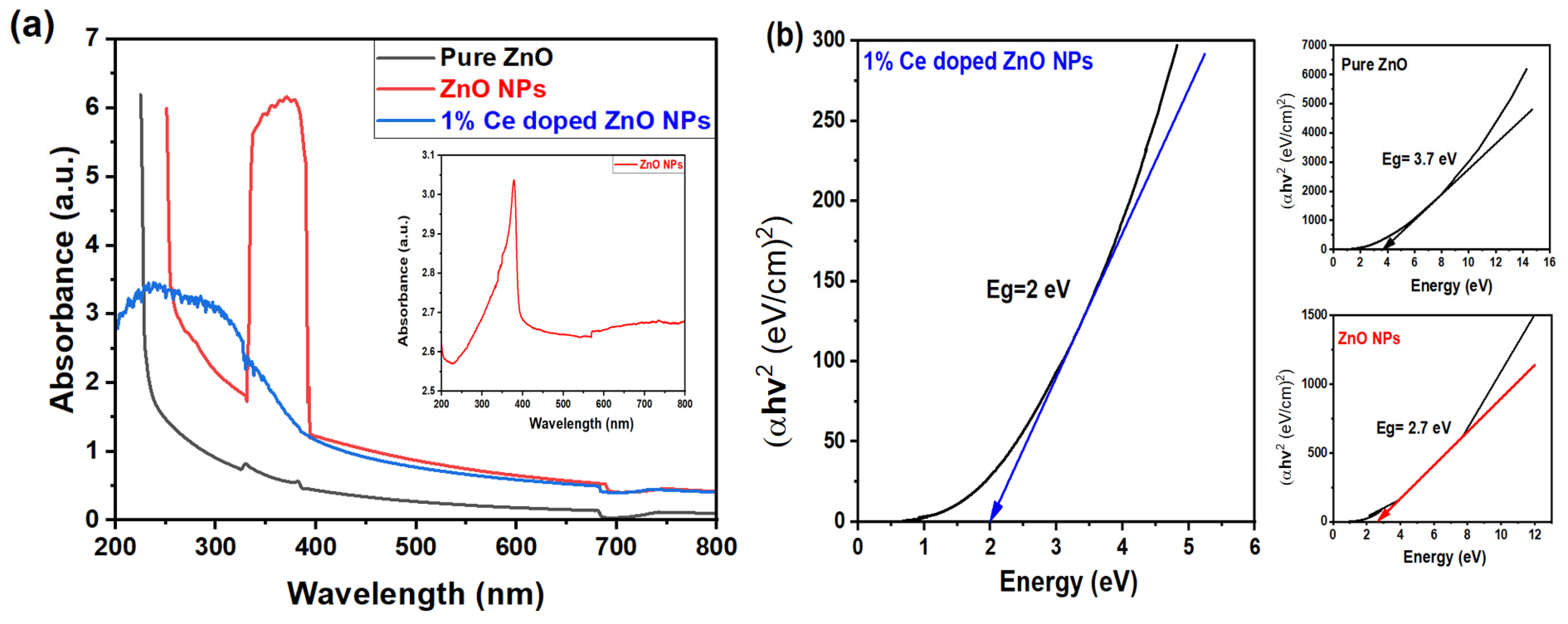

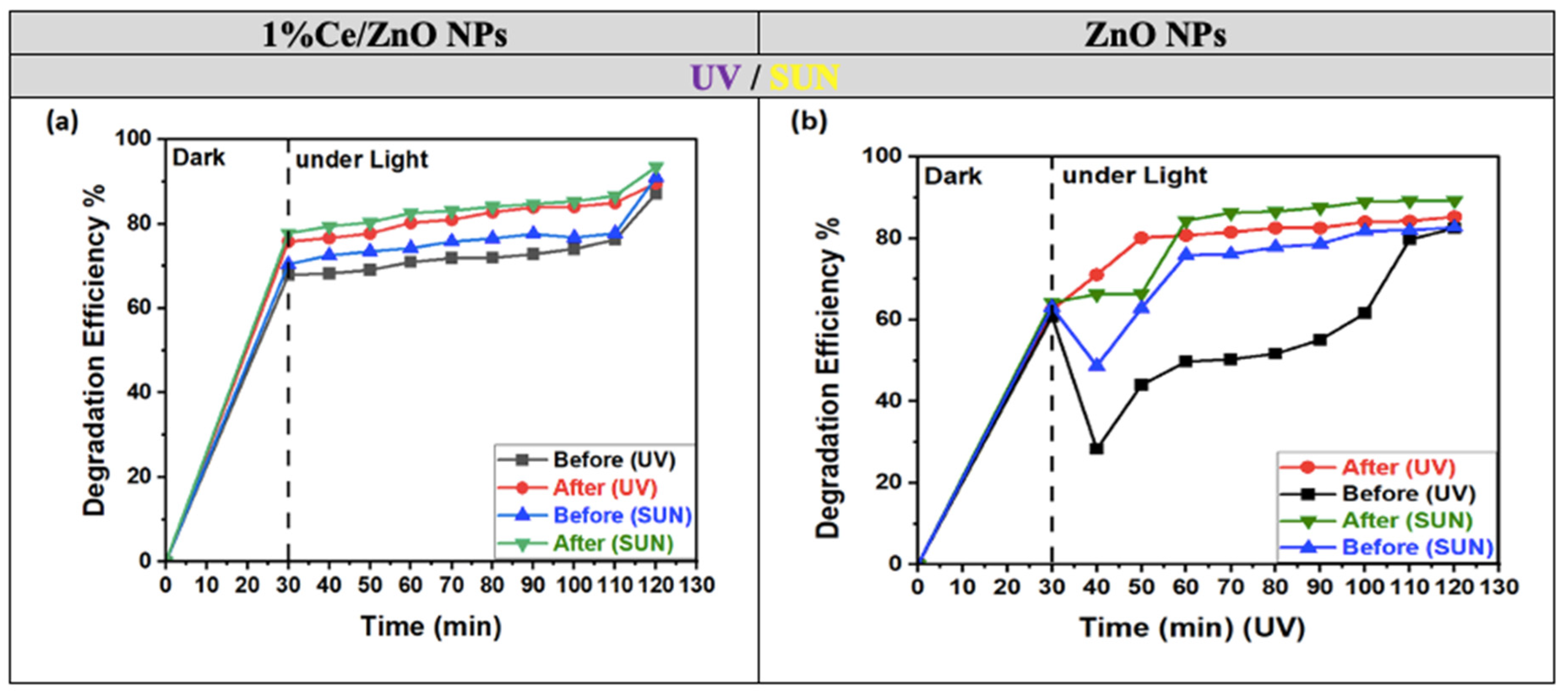
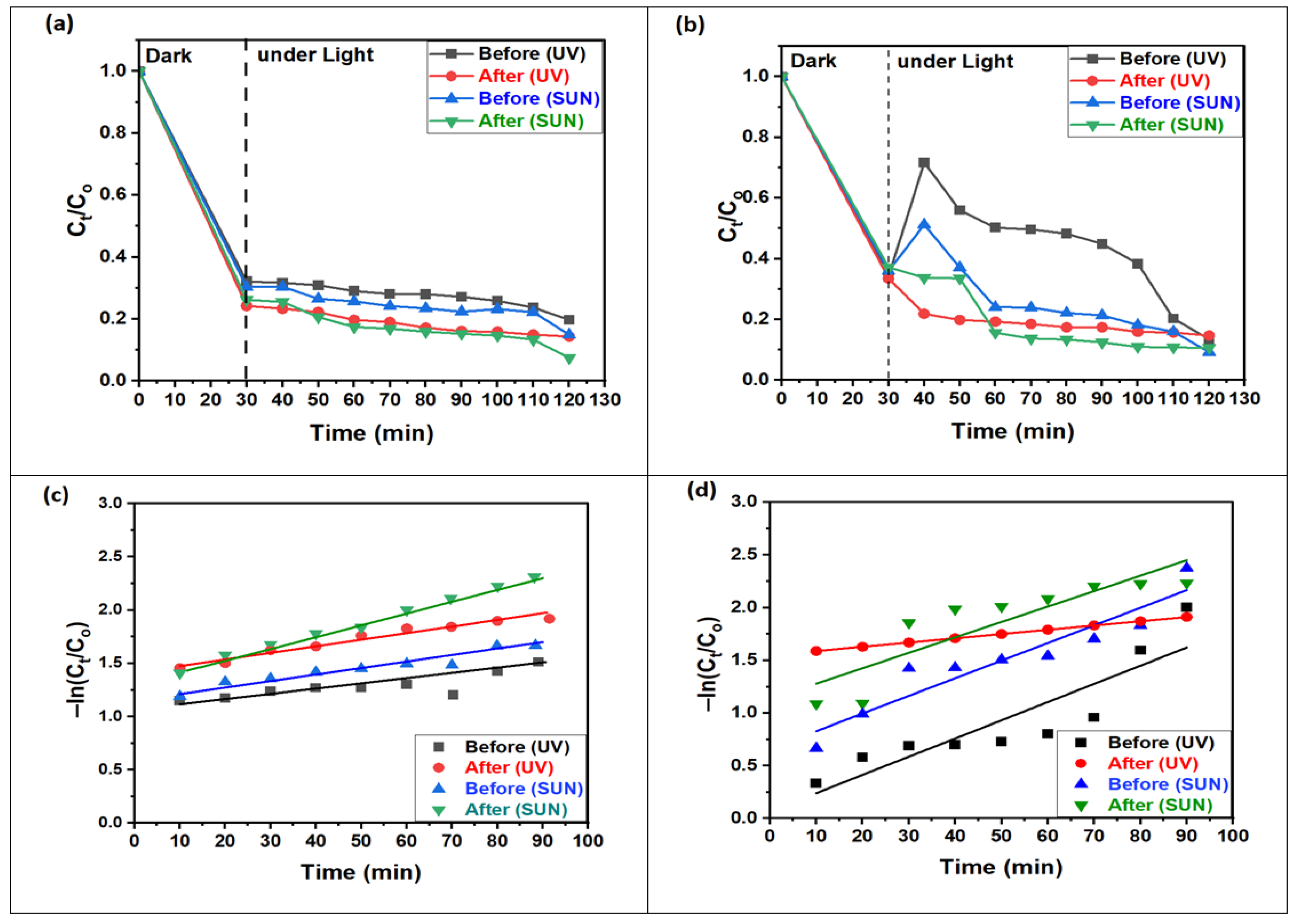

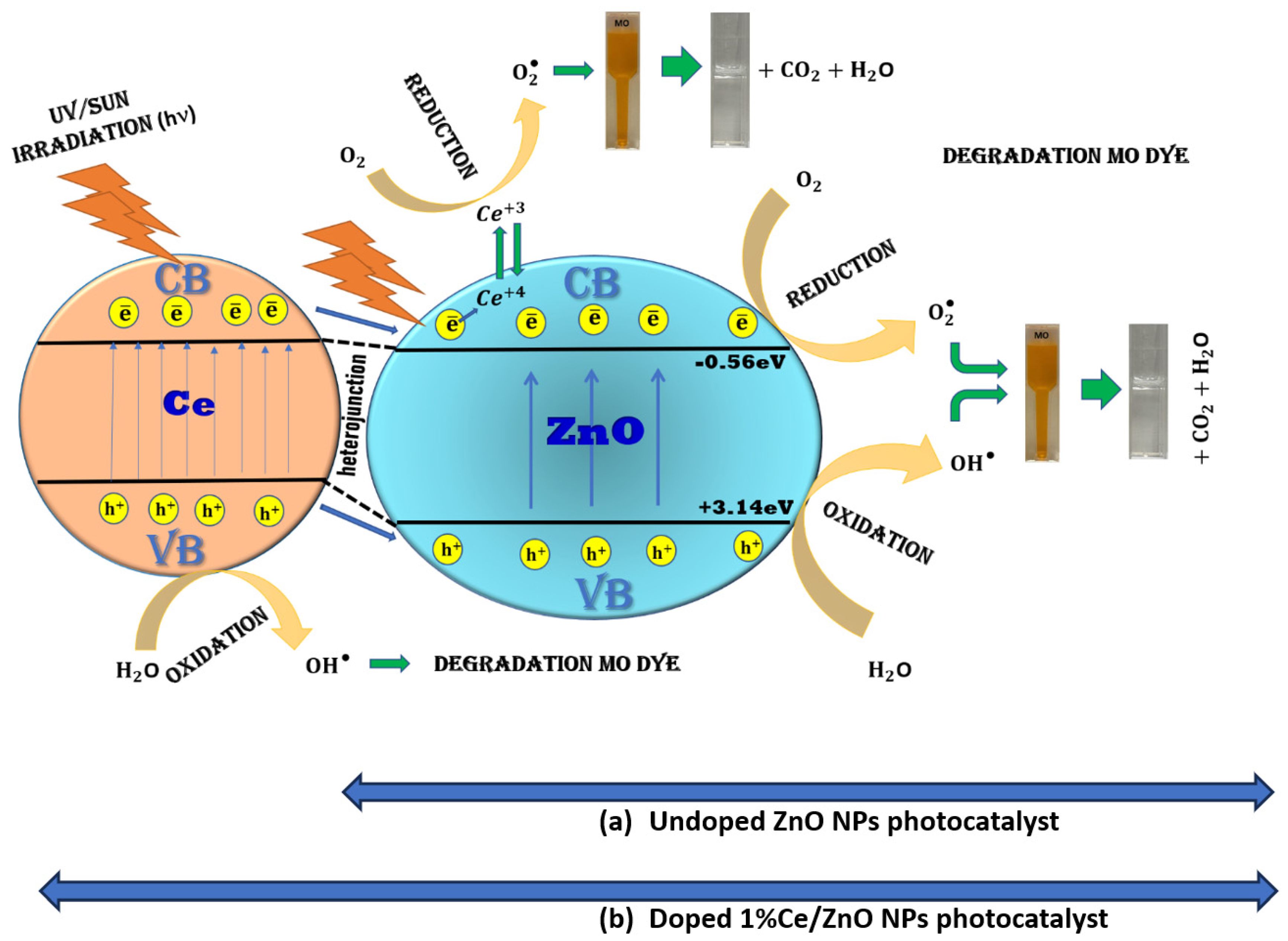
| Sample | XRD | |||||||
|---|---|---|---|---|---|---|---|---|
| Wurtzite Hexagonal ZnO Phase | Cubic-Structured CeO2 Phase | |||||||
| a (nm)100 | c (nm)002 | c/a | D (nm)ave | Xc002 | ||||
| Undoped ZnO | 0.3238 | 0.5221 | 1.612 | 117 | 1.493 | a (nm)111 | c/a | D (nm)ave |
| 1% Ce-doped ZnO | 0.31857 | 0.5229 | 1.641 | 90 | 0.443 | 0.5356 | 1 | 19 |
| Sample | UV Radiation | Sunlight | ||||||||||
|---|---|---|---|---|---|---|---|---|---|---|---|---|
| E%—before | E%—after | E%—before | E%—after | |||||||||
| * 0–30 (min) | 30–40 (min) | 40–120 (min) | * 0–30 (min) | 30–40 (min) | 40–120 (min) | * 0–30 (min) | 30–40 (min) | 40–120 (min) | * 0–30 (min) | 30–40 (min) | 40–120 (min) | |
| ZnO NPs | 61 | 28 | 82 | 62 | 71 | 85 | 63 | 49 | 83 | 64 | 66 | 89 |
| 1% Ce-doped ZnO NPs | 67 | 68 | 87 | 78 | 77 | 92 | 70 | 72 | 91 | 78 | 80 | 95 |
| Sample | UV | SUN | ||||||
|---|---|---|---|---|---|---|---|---|
| before | after | before | after | |||||
| k (min−1) | R2 | k (min−1) | R2 | k (min−1) | R2 | k (min−1) | R2 | |
| ZnO NPs | 0.00404 | 0.70887 | 0.00417 | 0.81617 | 0.00672 | 0.78996 | 0.00663 | 0.84083 |
| 1% Ce-doped ZnO NPs | 0.0079 | 0.86034 | 0.01508 | 0.95236 | 0.0101 | 0.92149 | 0.0271 | 0.98526 |
| qe (mg·g−1) | qt (mg·g−1) | qe (mg·g−1) | qt (mg·g−1) | qe (mg·g−1) | qt (mg·g−1) | qe (mg·g−1) | qt (mg·g−1) | |
| ZnO NPs | 15.1663 | 17.2983 | 15.2951 | 17.0564 | 15.6168 | 18.1426 | 15.6598 | 17.8561 |
| 1% Ce-doped ZnO NPs | 17.5743 | 16.0498 | 17.1596 | 17.1226 | 17.5369 | 17.0119 | 17.5528 | 18.0999 |
Disclaimer/Publisher’s Note: The statements, opinions and data contained in all publications are solely those of the individual author(s) and contributor(s) and not of MDPI and/or the editor(s). MDPI and/or the editor(s) disclaim responsibility for any injury to people or property resulting from any ideas, methods, instructions or products referred to in the content. |
© 2023 by the authors. Licensee MDPI, Basel, Switzerland. This article is an open access article distributed under the terms and conditions of the Creative Commons Attribution (CC BY) license (https://creativecommons.org/licenses/by/4.0/).
Share and Cite
Ajil, A.H.; Ahmed, N.M.; Yam, F.K.; Zango, Z.U.; Wadi, I.A.; M. Binzowaimil, A.; Aldaghri, O.; Ibnaouf, K.H.; Cabrera, H. Enhancing Methyl Orange Degradation with Laser-Generated ZnO and Ce-Doped ZnO Nanoparticles. Appl. Sci. 2023, 13, 11857. https://doi.org/10.3390/app132111857
Ajil AH, Ahmed NM, Yam FK, Zango ZU, Wadi IA, M. Binzowaimil A, Aldaghri O, Ibnaouf KH, Cabrera H. Enhancing Methyl Orange Degradation with Laser-Generated ZnO and Ce-Doped ZnO Nanoparticles. Applied Sciences. 2023; 13(21):11857. https://doi.org/10.3390/app132111857
Chicago/Turabian StyleAjil, Awras H., Naser M. Ahmed, F. K. Yam, Zakariyya Uba Zango, Ismael A. Wadi, Ayed M. Binzowaimil, Osamah Aldaghri, Khalid H. Ibnaouf, and Humberto Cabrera. 2023. "Enhancing Methyl Orange Degradation with Laser-Generated ZnO and Ce-Doped ZnO Nanoparticles" Applied Sciences 13, no. 21: 11857. https://doi.org/10.3390/app132111857
APA StyleAjil, A. H., Ahmed, N. M., Yam, F. K., Zango, Z. U., Wadi, I. A., M. Binzowaimil, A., Aldaghri, O., Ibnaouf, K. H., & Cabrera, H. (2023). Enhancing Methyl Orange Degradation with Laser-Generated ZnO and Ce-Doped ZnO Nanoparticles. Applied Sciences, 13(21), 11857. https://doi.org/10.3390/app132111857










